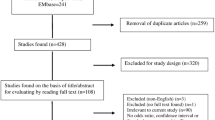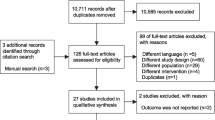Abstract
To appraise published studies on the use of supplemental oxygen in chronic heart failure. Chronic breathlessness is a characterizing symptom of symptomatic heart failure resulting in substantial disability and healthcare utilization and is the primary reason for emergency room visits and hospitalizations. In spite of the variable evidence, oxygen therapy is commonly administered both acutely and chronically. Moreover, the role of oxygen therapy to relieve chronic breathlessness in heart failure is not well described, particularly in normoxemic or mild or intermittent hypoxemic states. In fact, several studies have shown the detrimental effects of oxygen therapy with normal oxygen saturation levels. A systematic review using PRISMA guidelines. Four databases PubMed, Embase, CINAHL, and Web of Science were systematically searched from January 2001 to January 2019 investigating the use of oxygen in heart failure. Duplicate articles were removed from the review. Titles and abstracts were screened for inclusion and exclusion criteria. The remaining full-text articles were reviewed and hand-searched for additional references. The quality of the full-text articles was assessed using standardized critical appraisal instruments by the Joanna Briggs Institute. A total of 11 studies, including three intervention and eight non-interventions studies, were included in this review from 1072 non-duplicated records retrieved. Sample size ranged from 4 to 5862. In spite of common usage, this review suggests that there are scant data available to justify the use of oxygen in individuals with non-hypoxemic chronic heart failure and chronic breathlessness.

Similar content being viewed by others
References
Ponikowski P, Anker SD, AlHabib KF, Cowie MR, Force TL, Hu S, Jaarsma T, Krum H, Rastogi V, Rohde LE, Samal UC, Shimokawa H, Budi Siswanto B, Sliwa K, Filippatos G (2014) Heart failure: preventing disease and death worldwide. European Society of Cardiology Heart Failure 1(1):4–25
Savarese G, Lund LH (2017) Global public health burden of heart failure. Cardiac Failure Review 3(1):7–11
Center for Disease Control and Prevention (2016) Heart failure fact sheet, [Online]. Available: http://www.cdc.gov/dhdsp/data_statistics/fact_sheets/fs_heart_failure.htm. Accessed 31 Mar 2019
Davidson PM, Macdonald P, Moser DK, Ang E, Paull G, Choucair S, Daly J, Gholizadeh L, Dracup K (2007) Cultural diversity in heart failure management: findings from the DISCOVER study (part 2). Contemp Nurse 25(1–2):50–61
Clark AL, Johnson M, Fairhurst C, Torgerson D, Cockayne S, Rodgers S, Griffin S, Allgar V, Jones L, Nabb S, Harvey I, Squire I, Murphy J, Greenstone M (2015) Does home oxygen therapy (HOT) in addition to standard care reduce disease severity and improve symptoms in people with chronic heart failure? A randomised trial of home oxygen therapy for patients with chronic heart failure. Health Technol Assess 19(75):1–120
Booth S, Ryan R, Spathis A (2016) Service delivery of complex interventions for refractory breathlessness. Curr Opin Support Palliat Care 10(3):228–235
Bausewein C, Schunk M, Schumacher P, Dittmer J, Bolzani A, Booth S (2018) Breathlessness services as a new model of support for patients with respiratory disease. Chron Respir Dis 15(1):48–59
Johnson MJ, Yorke J, Hansen-Flaschen J, Lansing R, Ekström M, Similowski T, Currow DC (2017) Towards an expert consensus to delineate a clinical syndrome of chronic breathlessness. Eur Respir J 49(5):1602277. https://doi.org/10.1183/13993003.02277-2016. Print
Sepehrvand N, Ezekowitz JA (2016) Oxygen therapy in patients with acute heart failure: friend or foe? Journal of American College of Cardiology: Heart Failure 4(10):783–790
Mak S, Azevedo ER, Liu PP, Newton GE (2001) Effect of hyperoxia on left ventricular function and filling pressures in patients with and without congestive heart failure. Chest 120(2):467–473
Ahmadi Z, Currow DC, Ekstrom M (2017) Palliative oxygen for chronic breathlessness: what new evidence? Curr Opin Support Palliat Care 11(3):159–164
Coccia CB, Palkowski GH, Schweitzer B, Motsohi T, Ntusi NA (=2016) Dyspnoea: pathophysiology and a clinical approach. SAMJ: South African Medical Journal 106(1):32–36
Nishino T (2011) Dyspnoea: underlying mechanisms and treatment. Br J Anaesth 106(4):463–474
Breaden K, Collier A, Litster C, Allcroft P, Currow DC, Phillips JL (2019) Stigma and the in (visible) perspectives and expectations of home oxygen therapy among people with chronic breathlessness syndrome: a qualitative study. Palliat Med 33(1):82-90
Pattinson KT, Johnson MJ (2014) Neuroimaging of central breathlessness mechanisms. Curr Opin Support Palliat Care 8(3):225–233
Stoeckel MC, Esser RW, Gamer M, Buchel C, von Leupoldt A (2018) Dyspnea catastrophizing and neural activations during the anticipation and perception of dyspnea. Psychophysiology 55(4). https://doi.org/10.1111/psyp.13004
Hayen A, Herigstad M, Pattinson KT (2013) Understanding dyspnea as a complex individual experience. Maturitas 76(1):45–50
Riegel B, Moser DK, Anker SD, Appel LJ, Dunbar SB, Grady KL, Gurvitz MZ, Havranek EP, Lee CS, Lindenfeld J, Peterson PN, Pressler SJ, Schocken DD, Whellan DJ, American Heart Association Council on Cardiovascular Nursing, American Heart Association Council on Cardiovascular Nursing, American Heart Association Council on Clinical Cardiology, American Heart Association Council on Nutrition, Physical Activity, and Metabolism, American Heart Association Interdisciplinary Council on Quality of Care and Outcomes Research (2009) State of the science: promoting self-care in persons with heart failure: a scientific statement from the American Heart Association. Circulation 120(12):1141–1163
Cranston JM, Crockett A, Currow D (2008) Oxygen therapy for dyspnoea in adults. Cochrane Database Syst Rev (3)
Ameer F, Carson KV, Usmani ZA, Smith BJ (CD000238, 2014) Ambulatory oxygen for people with chronic obstructive pulmonary disease who are not hypoxaemic at rest. Cochrane Database Syst Rev 6
Vozoris NT, O’Donnell DE, Gill SS (2016) Opioids and adverse outcomes in elderly chronic obstructive pulmonary disease patients. Eur Respir J 48(6):1818–2016
Kanezaki M, Ebihara S (2017) Effect of the cooling sensation induced by olfactory stimulation by L-menthol on dyspnoea: a pilot study. Eur Respir J 49(4):1601823. https://doi.org/10.1183/13993003.01823-2016. Print
Simon ST, Higginson IJ, Booth S, Harding R, Weingärtner V, Bausewein C, Cochrane Pain, Palliative and Supportive Care Group (2016) Benzodiazepines for the relief of breathlessness in advanced malignant and non-malignant diseases in adults. Cochrane Database Syst Rev 2016(1):CD007354
McCarthy B, Casey D, Devane D, Murphy K, Murphy E, Lacasse Y (2015) Pulmonary rehabilitation for chronic obstructive pulmonary disease. Cochrane Database Syst Rev 2:CD003793
Coccia PF, Altman J, Bhatia S, Borinstein SC, Flynn J, George S, Goldsby R, Hayashi R, Huang MS, Johnson RH, Beaupin LK, Link MP, Oeffinger KC, Orr KM, Pappo AS, Reed D, Spraker HL, Thomas DA, von Mehren M, Wechsler DS, Whelan KF, Zebrack BJ, Sundar H, Shead DA (2012) Adolescent and young adult oncology clinical practice guidelines in oncology. JNCCN J Natl Compr Cancer Netw 10(9):1112–1150
Dube BP, Agostoni P, Laveneziana P (2016) Exertional dyspnoea in chronic heart failure: the role of the lung and respiratory mechanical factors. Eur Respir Rev 25(141):317–332
Kemp CD, Conte JV (2012) The pathophysiology of heart failure. Cardiovasc Pathol 21(5):365–371
Popay J, Roberts H, Sowden A, Petticrew M, Arai L, Rogers M, Britten N, Rosen K, Baldwin S, Duffy S (2003), Developing guidance on the conduct of narrative synthesis in systematic reviews. [Online]. Available: https://www.lancaster.ac.uk/shm/research/nssr/research/dissemination/publications/medsoc sept 05.pdf
Paul B, Joseph M, De Pasquale CG (Jun. 2008) Domiciliary oxygen therapy improves sub-maximal exercise capacity and quality of life in chronic heart failure. Heart Lung Circ 17(3):220–223
Campbell ML, Yarandi H, Dove-Medows E (2013) Oxygen is nonbeneficial for most patients who are near death. J Pain Symptom Manag 45(3):517–523
Itoh T, Ooiwa H (2014) Successful treatment with high-flow nasal oxygen therapy in four patients with congestive heart failure resistance to conventional oxygen supply. J Card Fail 20(10):S151–S152
Rutten FH, Heddema WS, Daggelders GJA, Hoes AW (2012) Primary care patients with heart failure in the last year of their life. Fam Pract 29(1):36–42
Currow DC, Agar M, Smith J, Abernethy AP (2009) Does palliative home oxygen improve dyspnoea? A consecutive cohort study. Palliat Med 23(4):309–316
Chouihed T, Manzo-Silberman S, Peschanski N, Charpentier S, Elbaz M, Savary D, Bonnefoy-Cudraz E, Laribi S, Henry P, Girerd N, Zannad F, el Khoury C (2016) Management of suspected acute heart failure dyspnea in the emergency department: results from the French prospective multicenter DeFSSICA survey. Scand J Trauma Resusc Emerg Med 24(1):112
Oguz S, Enc N (2008) Symptoms and strategies in heart failure in Turkey. Int Nurs Rev 55(4):462–467
Roca O, Pérez-Terán P, Masclans JR, Pérez L, Galve E, Evangelista A, Rello J (2013) Patients with New York Heart Association class III heart failure may benefit with high flow nasal cannula supportive therapy: high flow nasal cannula in heart failure. J Crit Care 28(5):741-746
Stefan MS, Eckert P, Tiru B, Friderici J, Lindenauer PK, Steingrub JS (2018) High flow nasal oxygen therapy utilization: 7-year experience at a community teaching hospital. Hosp Pract 46(2):73-76
Park JH, Balmain S, Berry C, Morton JJ, McMurray JJ (2010) Potentially detrimental cardiovascular effects of oxygen in patients with chronic left ventricular systolic dysfunction. Heart 96(7):533-538
de Tejada MG-S et al (2019) Responsiveness and minimal clinically important difference of the Minnesota living with heart failure questionnaire. Health Qual Life Outcomes 17(1):32–36
Stefan MS, Priya A, Pekow PS, Lagu T, Steingrub JS, Hill NS, Nathanson BH, Lindenauer PK (2018) The comparative effectiveness of noninvasive and invasive ventilation in patients with pneumonia. J Crit Care 43:190–196
Author information
Authors and Affiliations
Corresponding author
Ethics declarations
Conflict of interest
No conflict of interest has been declared by the authors.
Additional information
Publisher’s note
Springer Nature remains neutral with regard to jurisdictional claims in published maps and institutional affiliations.
Electronic supplementary material
ESM 1
(DOCX 14 kb).
Appendix
Appendix
(“Oxygen use” OR “oxygen therapy”) AND (“breathlessness” OR “dyspnea”) AND ((“Heart Failure”[Mesh] OR “cardiac failure” OR “heart decompensation” OR “heart failure” OR “myocardial failure” OR “chf” [tiab]))
Rights and permissions
About this article
Cite this article
Asano, R., Mathai, S.C., Macdonald, P.S. et al. Oxygen use in chronic heart failure to relieve breathlessness: A systematic review. Heart Fail Rev 25, 195–205 (2020). https://doi.org/10.1007/s10741-019-09814-0
Published:
Issue Date:
DOI: https://doi.org/10.1007/s10741-019-09814-0




